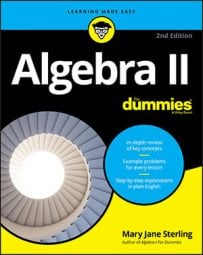Radicals can make equations very difficult to work with. Fortunately, it's possible to get rid of a radical by squaring both sides of the equation; for this method to work, the equation must be in the form
The only problem arises when you end up with an extraneous root. Consider the non-equation –3 = 3. You know that the equation isn't correct, but what happens when you square both sides of this statement? You get (–3)2 = (3)2, or 9 = 9. Now you have an equation. Squaring both sides can mask or hide an incorrect statement.
Much like the process of getting rid of fractions in equations, the method of squaring both sides is the easiest way to deal with radicals in equations. You just accept that you always have to watch for extraneous roots when solving equations by squaring.
For example, to solve the equation
follow these steps:
Change the equation so that the radical term is by itself on the left.
In this case, you add 6 to each side of the equation.
Square both sides of the equation.
Note that a very common error when squaring problems is to square the binomial on the right incorrectly. Don't forget the middle term — you can't just square the two terms alone [(a + b)2 = a2 + 2ab + b2].
Simplify the result and solve the resulting equation.
In this example, you have a quadratic equation. Set it equal to zero and solve it:
When x + 3 = 0, x = –3. When x + 5 = 0, x = –5.
Check to see whether your solutions fit with the original equation.
Plug your answers in the original equation,
When x = –3,
It works. Checking x = –5, you get
This solution works, too.
Both solutions working out is more the exception rather than the rule when you're dealing with radicals. Most of the time, one solution or the other works, but not both. And, unfortunately, sometimes you go through all the calculations and find that neither solution works in the original equation. You get an answer, of course (that there is no answer), but it isn't very fulfilling.

